Even with all of her problems, she looked damned good:
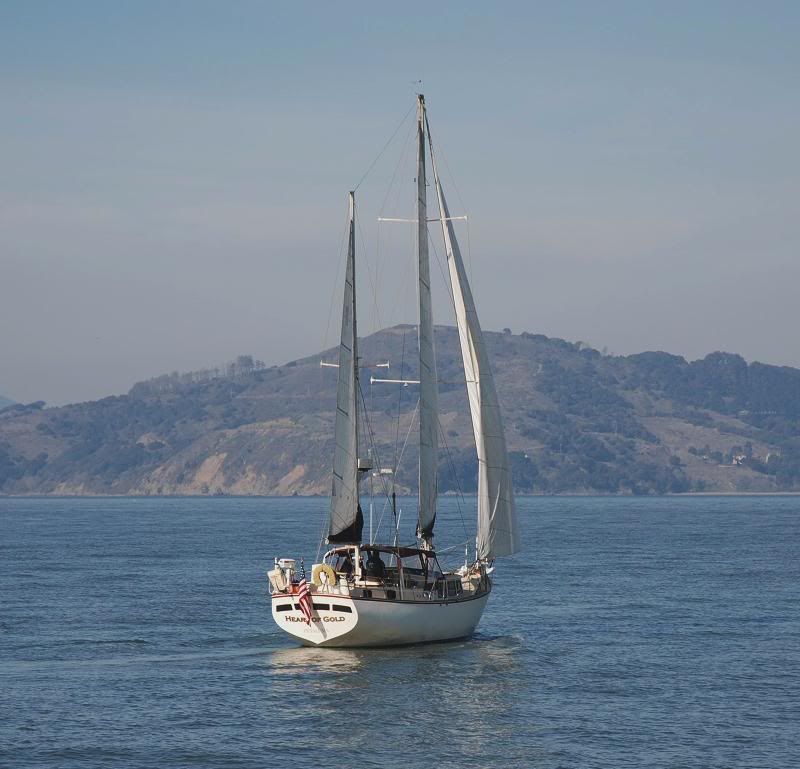
The plan was to go out to sea, pay off all my bills, and then return to California with a fat checkbook and tons of free time about four months later. Then I got mobilized and sent to Afghanistank. That added almost ten months of waiting before I'd get a chance to get started on any of the repairs on the ever-growing list.
If you're a mariner, you know that any moment of neglect will have to be paid for with interest later on. By putting off required maintenance or repairs today, you can count on even more work to take care of tomorrow. So for the past year, every time I've thought of my boat, I've mostly been dreading the ever-growing pile of corrective maintenance that was waiting for me on board.
In an effort to get a bit of a headstart while I was still deployed, I convinced my parents to pull the sails and take them to Rooster Sails, an excellent sail loft in Alameda, California. Right before I was mobilized some of the seams had started to give out while Ana and I were underway, so I was figuring I'd probably have to replace them altogether. Still, I was hopeful that I might find some sort of sailmaking wizard who could resurrect them for just a bit more use.
That wizard turned out to be Rui Luis of Rooster Sails. Rui is one of the nicest guys I've ever met and made me a great deal as a way of saying thanks for my service in Afghanistan. He does great work too, and I can't recommend him enough to anyone in the market for sail repairs. If you stop by, tell him Shawn Thorsson sent you.
For every good thing that happens though, Karma feels a need to add a bad thing. While Rui was taking care of my sails, I was running into all sorts of problems getting the rigging taken care of. I'll admit that I wasn't doing very much, but that was because I was half the world away with less-than-reliable access to a phone or email. Over email, the folks at Hansen Rigging told me in February that they should be able to stop by sometime the following week, survey the rigging on the boat, and let me know what needs to be taken care of.
Fast forward from February to late June, through another dozen emails, and five more phone conversations in which they promised to stop by "next week," and they still hadn't sent anyone down to the boat. At this point I'd called for the umpteenth time and told the owner that I really needed a survey of the rigging done before I actually returned to the state.
So after months of coaxing, someone from the company ended up meeting with my father on the boat. Among other things, the rigging surveyor brought along a German Shepherd which apparently bit my old man early on in the meeting (which is reason enough to keep me from doing business with them). Then when he got to the boat he did some cursory looking around before deciding that there was no way that any of the gear was still serviceable.
His solution: move the boat down to their shop on the other side of the Bay, pull the masts out, disassemble them completely, replace all of the shiny parts, and then reassemble them, re-step them, and re-rig them.
The estimated cost: $13,000. That's US dollars.
The problem was that his estimate included repairs to a lot of pieces that I just plain don't need. All I asked for was the cost to replace the standing rigging, but they wanted to tear out the whole rig and rebuild it from bow to stern. While I can't do all that myself, I know I can pull the wire shrouds and stays off by myself, take them to a shop to have duplicates made in shiny new marine-grade stainless steel, and then re-install them without paying thousands of dollars in labor costs. I'd like to take credit for that idea, but Rui at Rooster Sails gave me that one too.
Anyway, once I finally got back to Petaluma in July of this year I was really worried about finding out what was waiting for me in my slip at the marina. It turns out that after ten months without me the boat still floats:
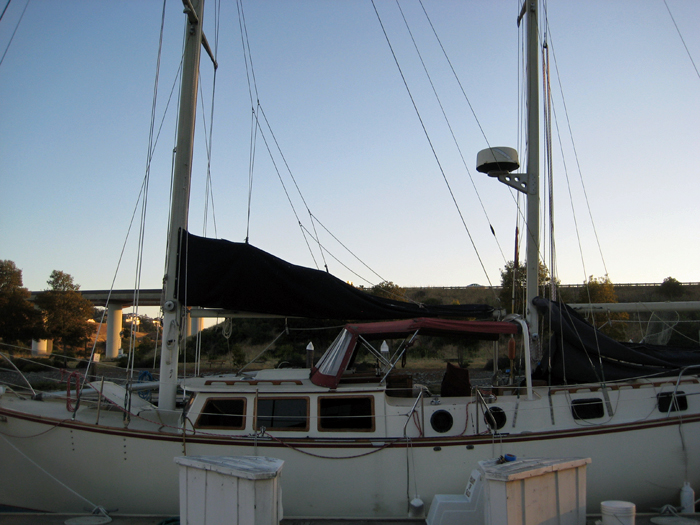
The fact that it still floats is a minor success of sorts when you consider all of the extra weight in birdshit on board. On deck things were in a bit of disarray, but not so bad:
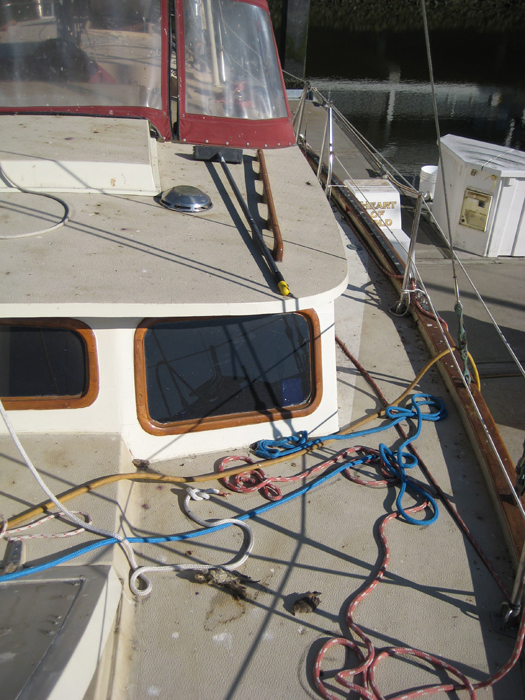
In fact, the only real surprise I found topside were these two little corpses:
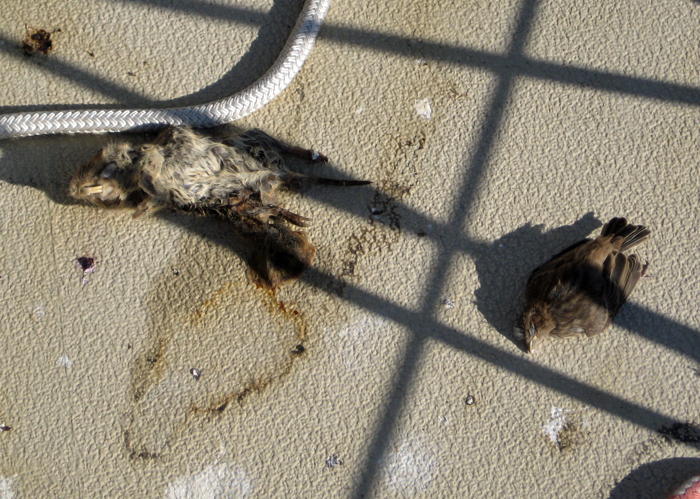
The bird on the right makes sense to me. When birds die they have to land somewhere, so landing on my deck makes as much sense as anything. It's the gopher carcass on the left that has me troubled. There's no good reason to expect to find a gopher on a boat. Later I also noticed a little pellet of fur and teeth that suggest that there was some random raptor perching in my rigging for a few meals while I was gone. Cool.
But I digress...
After giving the decks a good sweepdown fore and aft, I set to work on the lower set of shrouds (the wires that keep the masts from falling sideways). I figure there's an upper set that will steady the masts as well, so things should be alright when I leave the lowers out for a week while new ones are made.
Here's a shot of me loosening the turnbuckles:
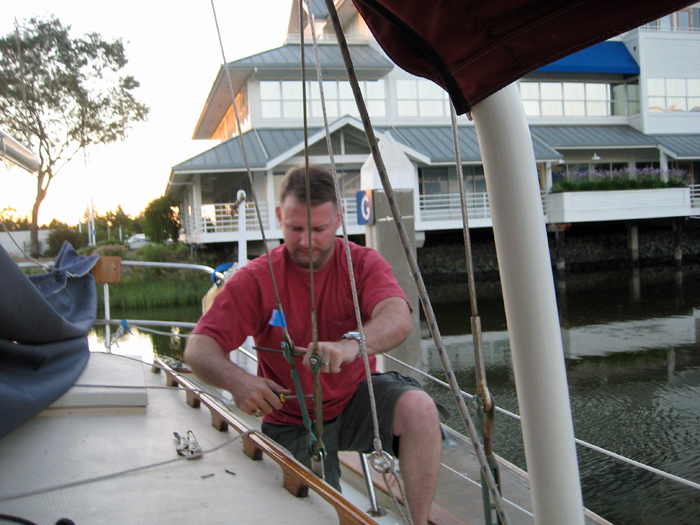
And here's a shot of me in the bosun's chair pulling the pins at the top ends of the mizzenmast shrouds:

Fortunately, when I pulled the pins the mast didn't collapse.
For her part, Ana helped by hanging out down below:

The next day I took the shrouds down to the rigging shop at Svendsen's Boat Works where they'll be able to fabricate a brand new set in about five days. So now I've got the rigging problem about 25% solved.
All I have to do now is replace the generator, install a new refrigeration system, install a stove, replace all the wiring, have new canvas made, install an inverter, upgrade the interior upholstery, sand and coat all of the brightwork, get new cockpit cushions, repaint the spars, rebuild the roller furler, convert all of the cabin lights to LED bulbs, replace all the old plastic portholes with bronze ones, and scrub the diesel smell out of the bilges, and build a dinghy. No sweat.
Stay tuned for the next exciting chapter...

No comments:
Post a Comment